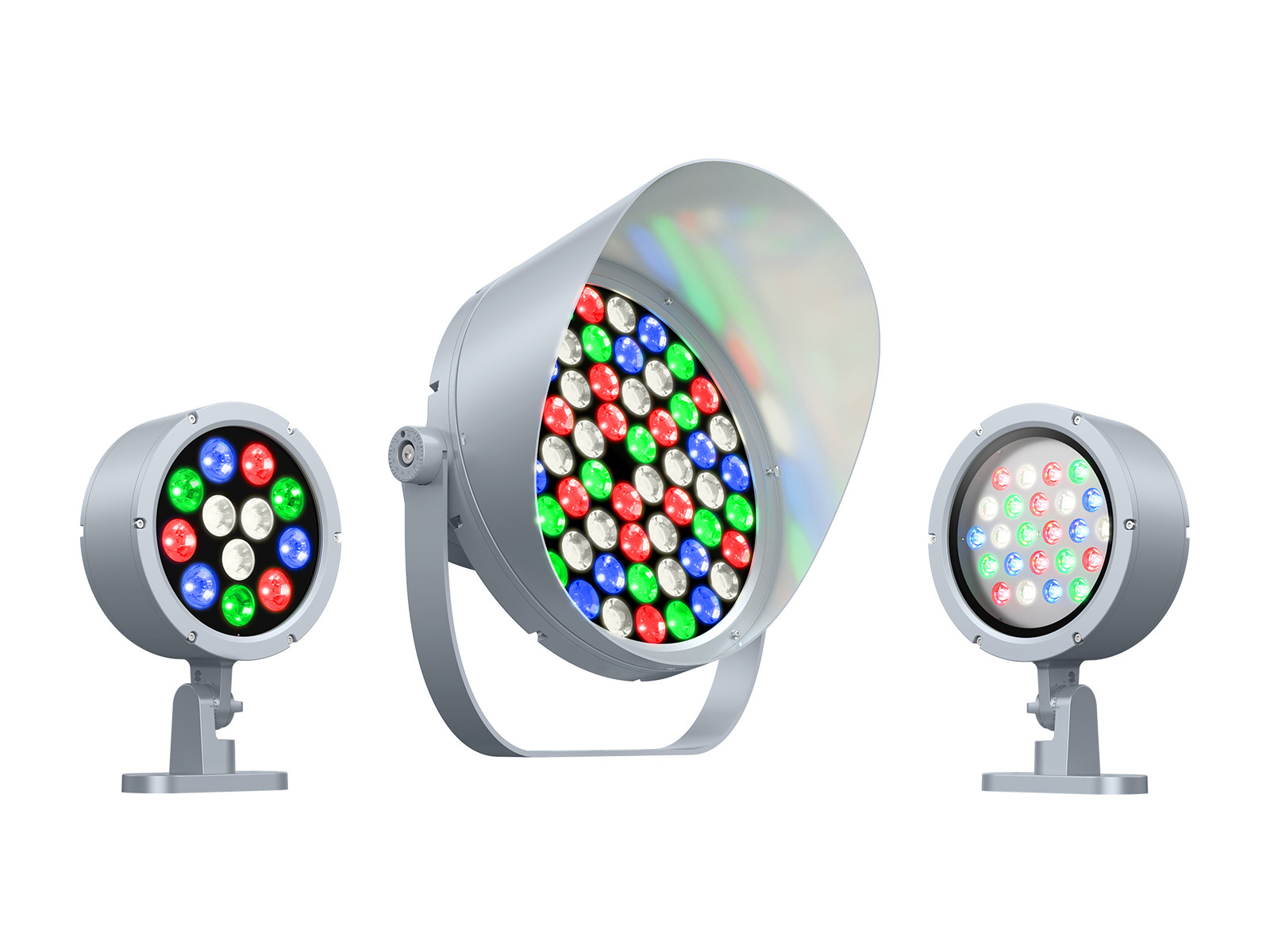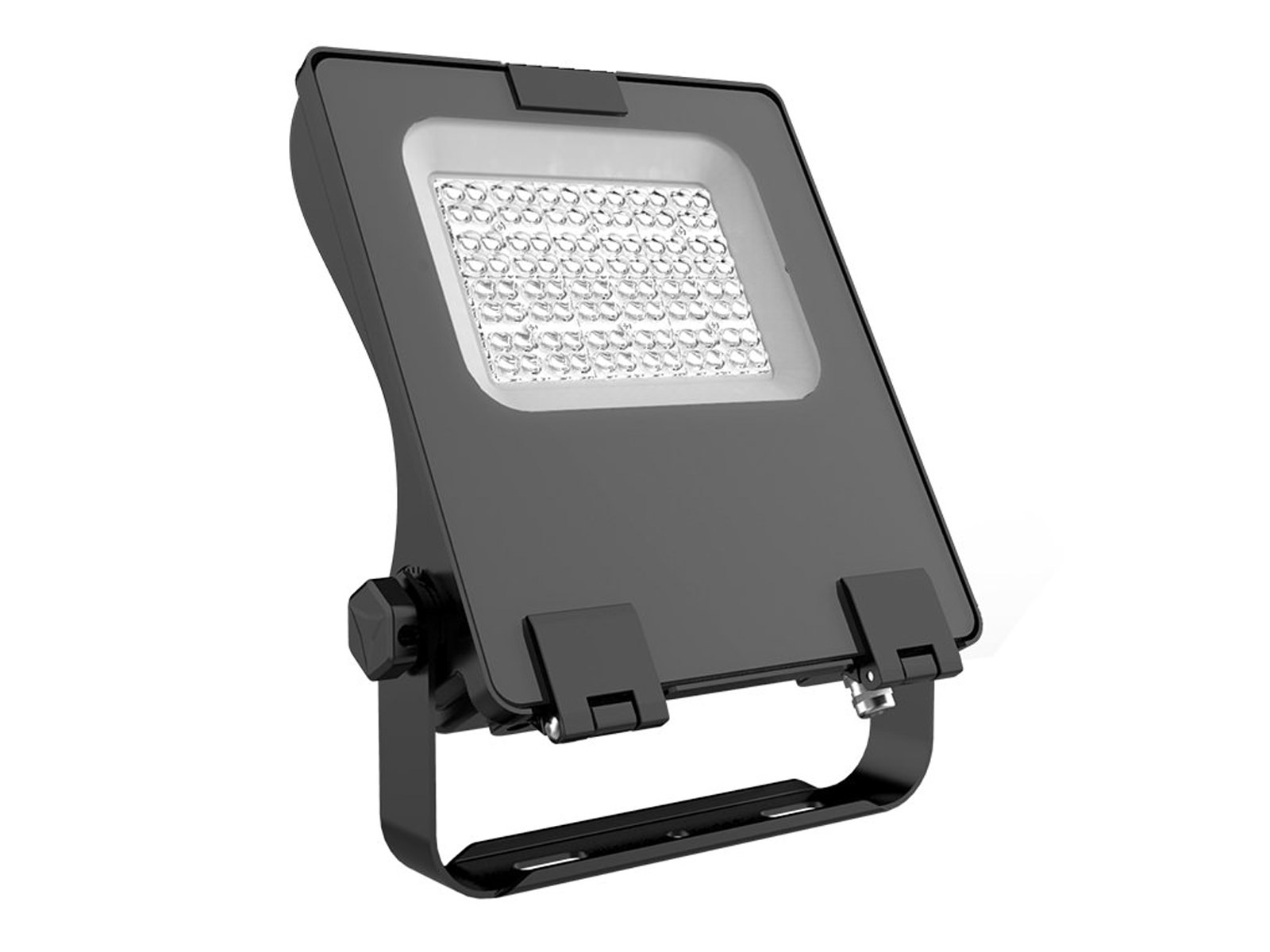Have you ever wondered how some buildings look so amazing and captivating at night? How do they create a stunning visual impact and attract the eyes of viewers? How do they enhance the beauty and identity of the architecture and the city?
The answer is facade lighting design.
Facade lighting design is the art of using light to illuminate and accentuate the exterior of a building, creating a dynamic and memorable impression. It is not just about adding some lights to the facade but about understanding the structure, context, and purpose of the lighting. It is about creating a balance between aesthetics, functionality, and sustainability.
In this article, we will cover everything you need to know about facade lighting design, from basic techniques and principles to the design for different building materials and sustainability considerations.
Basic principles of facade lighting design
Facade lighting design is a complex and creative process that requires careful consideration of a building’s architecture, environment, and intended effect. The basic principle of facade lighting design is to highlight the building’s unique architectural features, whether it’s a historic landmark or a modern office building. Each structure possesses distinctive elements that can be accentuated through the use of lighting. By highlighting these features with light, you can create a visually interesting and dynamic effect that draws the eye and enhances the overall appearance of the building.
Light levels are a primary consideration in facade lighting design. It is important to avoid illumination that is too bright or intense, as it can cause glare and overexpose details. Recommended luminance ranges vary depending on the type of building: for residential buildings, a range of 5-15 footcandles is recommended; for commercial storefronts, a range of 20-50 footcandles is suitable; and for monuments, a range of 10-30 footcandles is recommended. Brighter and more vibrant hues can be used to highlight focal points and create visual interest.
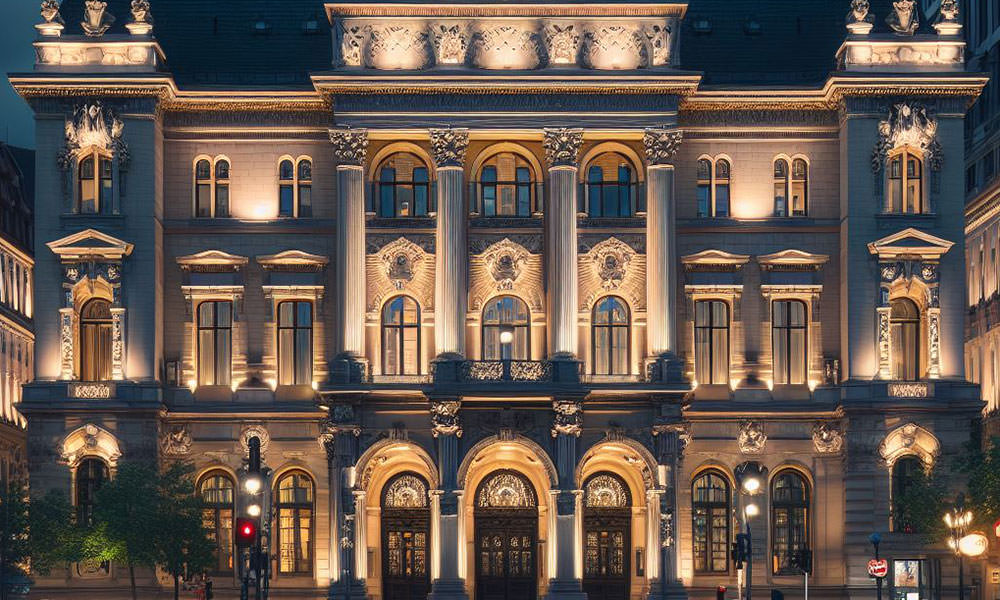
Color temperature plays a significant role in influencing the ambiance and visual impact of facade lighting. Warm white light in the 3000K range adds a comfortable and cozy feel. On the other hand, cooler shades around 5000K create contrast and vibrancy. The use of color-changing LEDs allows designers to dynamically alter the mood of the facade.
Strategic light placement is crucial in achieving the desired effect. Uplighting from below the building creates depth and reveals the architectural forms. Downlighting is effective in minimizing shadows and glare. Grazing light across surfaces accentuates textures and adds dimension. Side lighting is used to illuminate without overexposing certain areas. Flood lighting evenly washes the entire facade, while accent lighting spotlights specific details, entryways, or features. Combining flood and accent lighting provides a balanced approach to the overall design.
Sustainability is a critical consideration in facade lighting design. Energy-efficient LED lighting and smart lighting controls can significantly reduce energy consumption and minimize the environmental impact. It is important to consider the effect of lighting on wildlife and implement measures to mitigate any negative effects. Additionally, long-term maintenance of lighting fixtures should be taken into account to ensure a sustainable and environmentally friendly design approach.
Techniques of facade lighting design
Lighting techniques are the methods or approaches used to apply light to the facade, creating various effects and impressions. There are several common lighting techniques employed in facade lighting design. Here are some of the most prevalent ones:
Uplighting
This technique involves placing fixtures on the ground, angled upwards towards the facade. The light grazes the exterior walls, highlighting textures and architectural details. Uplighting adds depth and dimension to the building's appearance. In the case of taller structures, lighting can be placed on intermediate levels to illuminate higher floors and the roofline.
Downlighting
In contrast to uplighting, downlighting uses fixtures that are angled down from above. This technique minimizes glare and shadows. However, if not properly executed, it can flatten details and textures. The use of diffusers and optics is crucial to soften and spread downlighting effectively.
Accent lighting
Accent lighting is focused on specific design features, architectural details, entranceways, or signage. By combining accent lighting with general wash lighting, designers can create a sense of hierarchy and points of interest on the facade. Fixtures with adjustable heads or beams allow for precise highlighting of key areas.
Design for different building materials
One of the challenges in facade lighting design is adapting to the various building materials used for the exterior of buildings. Different materials possess unique properties, including reflectivity, transparency, texture, and color, which influence how light interacts with them. Therefore, it is crucial to comprehend the characteristics of each material and select suitable lighting techniques and fixtures accordingly.
Modern high-rise buildings often feature expansive glass and steel elements, and the lighting design should complement their sleek and gleaming aesthetic. Cool white or colored LEDs in the 5000-6500K range work well with glass to create contrast and vibrancy. Linear LED lights or strategically placed flood lights can be used to achieve a visually stunning effect. However, it is important to consider the reflectivity of glass and avoid creating glare or reflections that could be distracting or uncomfortable for viewers. For instance, our FL08 LED flood lights can be utilized for illuminating a glass building facade. These lights provide bright and consistent lighting, creating a striking and majestic contrast with the night sky.
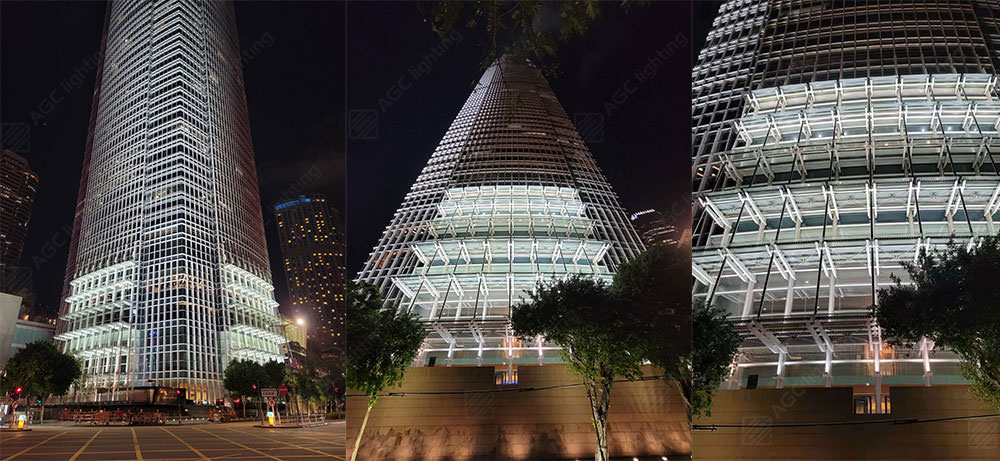
Stone and brick facades require lighting that enhances the texture and warmth of these materials. Lower color temperatures in the range of 3000-4000K are suitable to match the inherent tone of the materials. Facade grazing fixtures can be used to cast small shadows that emphasize the tactile nature of the masonry. Direct or grazing lighting techniques, such as wall washers, can create a strong contrast and add a sense of drama to the facade.
For example, we have provided a perfect lighting solution for the town hall's facade. Our innovative designs and asymmetric optics in the FL08 lighting fixtures allow them to highlight the building effectively without disturbing the surrounding architecture. The combination of these features ensures that the town hall's facade is properly illuminated, showcasing its beauty and architectural details.
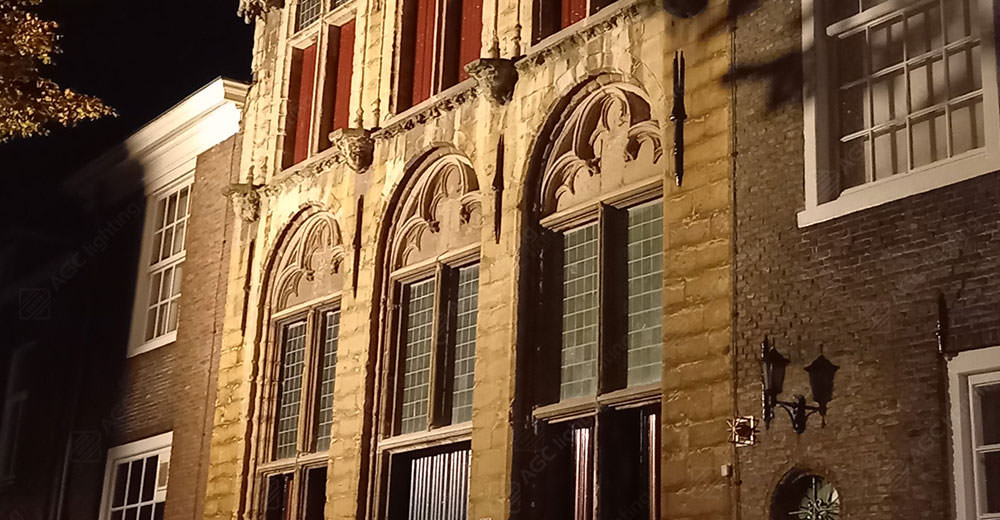
RGB lighting can indeed bring a colorful and dramatic atmosphere to the facade. In cases where the client desires a vibrant lighting scheme to reinforce their brand image, RGB lighting can be an excellent choice. Our FL39 RGB LED flood light, featuring DMX control, provides the capability to generate rich and saturated colors, allowing for unlimited lighting designs and effects. With the flexibility of DMX control, the lighting can be precisely programmed to create dynamic lighting shows. This solution ensures that the facade lighting aligns with the client's vision and effectively enhances their brand image.
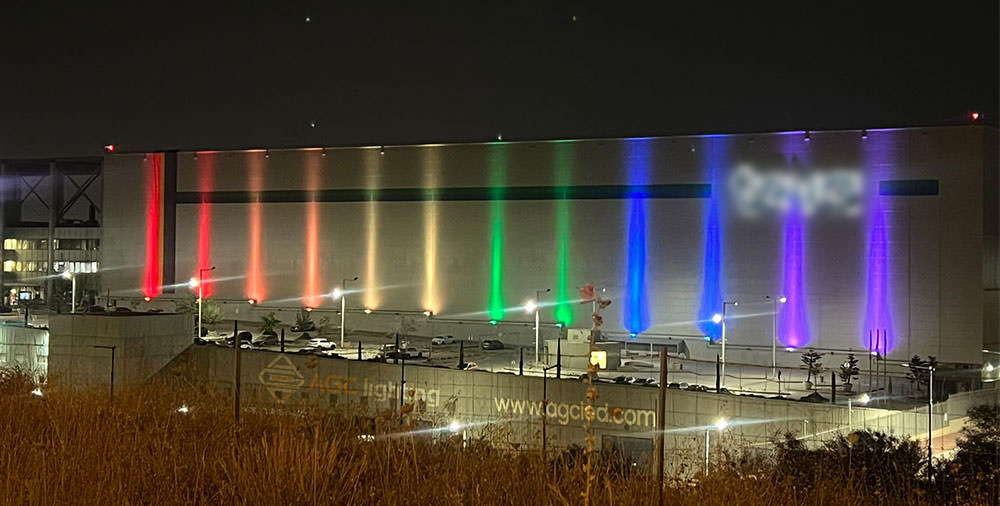
When it comes to historic buildings, a minimalist lighting approach is often preferred to protect the architectural heritage while still providing visibility and safety. The use of warm light tones in the range of 2500-3000K helps to harmonize with existing lamp posts and period buildings, creating a cohesive and authentic atmosphere. In this context, it is recommended to focus uplighting on entryways, signs, and ornamental details, rather than uniformly washing the entire exterior surface. By using accent lighting strategically, the architectural features can be highlighted without overpowering the building's character.
Sustainability considerations
Facade lighting design is not only about creating a visual impact and meaningful expression but also about being responsible and respectful towards the environment and society. Facade lighting design should consider the sustainability aspects of the lighting project, such as energy consumption, light pollution, and social impact. Here are some of the main sustainability considerations that every facade lighting designer should take into account.
Energy consumption
The amount of energy that is used to power the facade lighting system affects the operational costs and environmental impact of the lighting project. LED fixtures are the primary selection as they are more energy-efficient, durable, and versatile than other types of lighting sources. LED fixtures can also be integrated with smart lighting control systems, such as 0-10V dimming and DMX control, that can adjust the light intensity and duration according to the needs and preferences of the users and the environment.
Light pollution
The amount of artificial light that is emitted by the facade lighting system affects the natural cycles and behaviors of humans, animals, and plants. Light pollution can also cause glare, skyglow, and clutter, which can reduce the visibility and quantity of the night sky and stars. To reduce light pollution, you can use dark sky-compliant fixtures, which are designed to minimize light trespass, spillage, and upward emission. Dark sky compliant fixtures can also enhance the contrast and clarity of the facade lighting design, as well as preserve the beauty and value of the night sky.
Social impact
Social impact can also include the cultural and historical significance of the building and its context. To create a positive social impact, you can involve and engage the users and stakeholders in the planning and execution of the lighting project. You can also use dynamic and interactive lighting features, such as color changing or motion sensing, that can create a sense of fun and excitement for the users.
Facade lighting is a powerful tool that can transform the entire aesthetic appeal of a building, creating a captivating visual experience for both occupants and passersby. By carefully considering various factors such as architectural elements, color schemes, lighting techniques, and sustainability, you can elevate and overall ambiance and mood of the building.
As a leading lighting manufacturer, AGC provides cutting-edge lighting solutions that not only enhance the beauty of buildings but also optimize energy efficiency and minimize environmental impact.
If you are looking to take your next facade lighting project to the next level, get in touch with our team of lighting experts. We’re happy to collaborate with you and provide solutions tailored to your needs. Simply click below to request a quote or schedule a consultation with us today!













